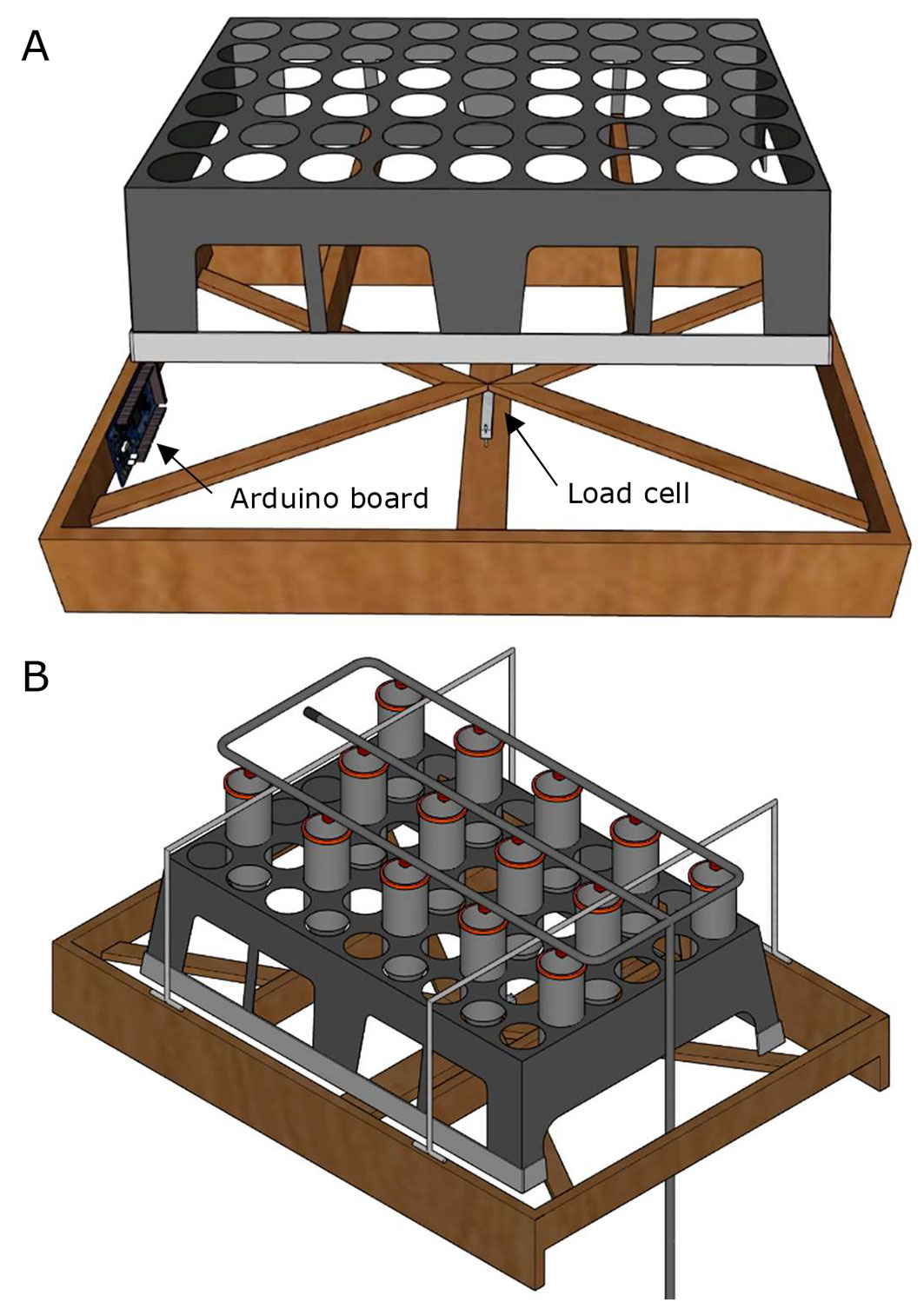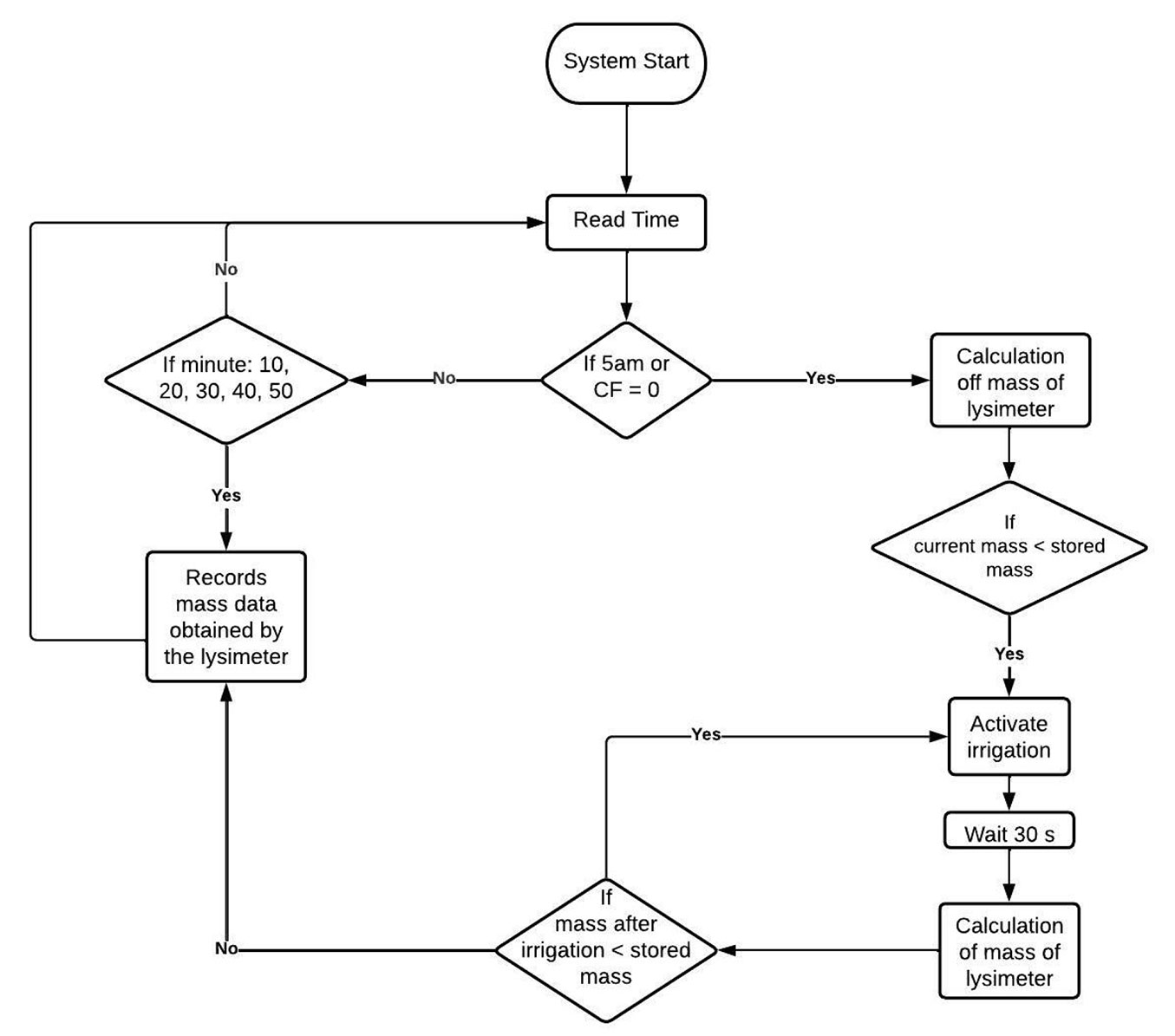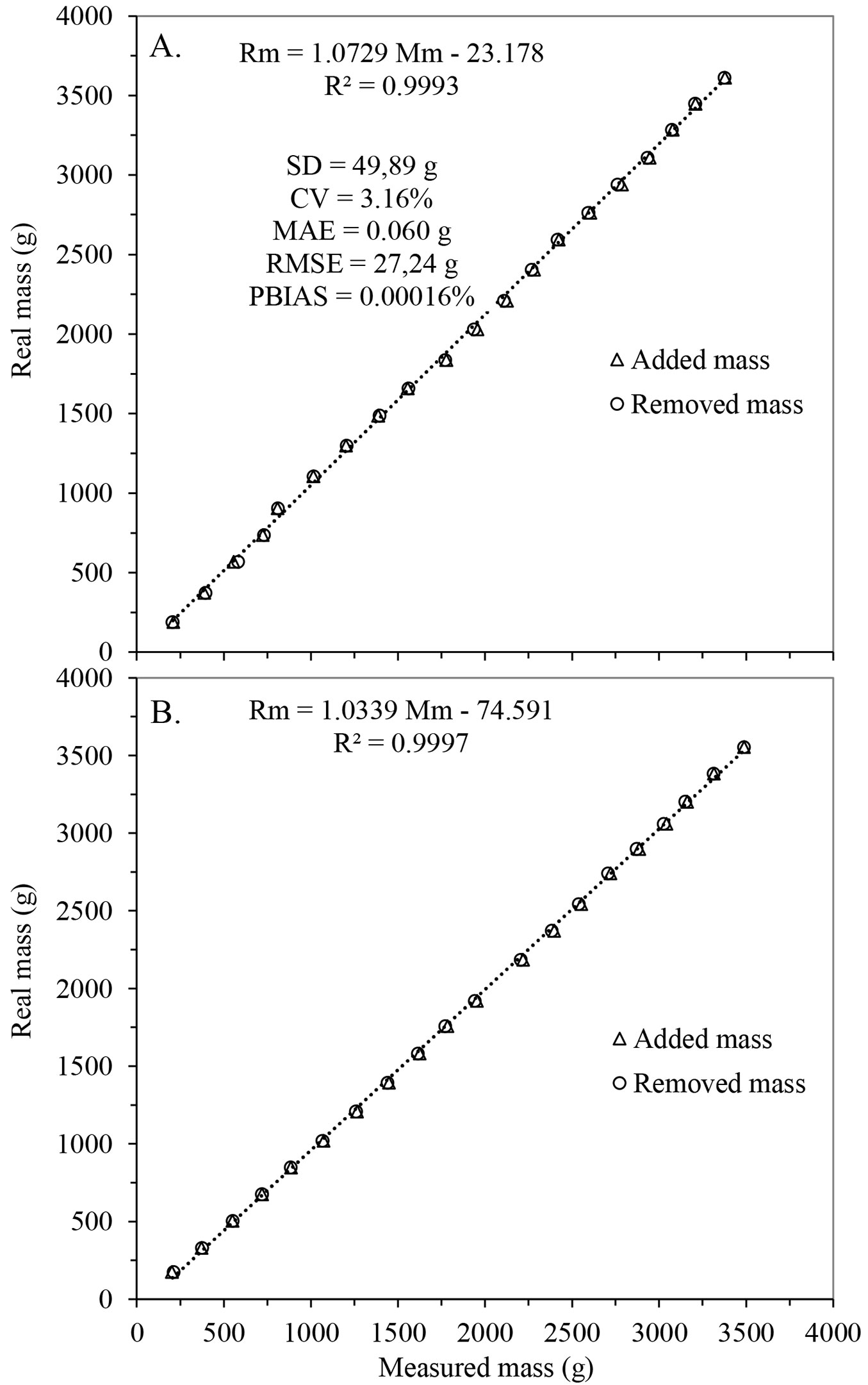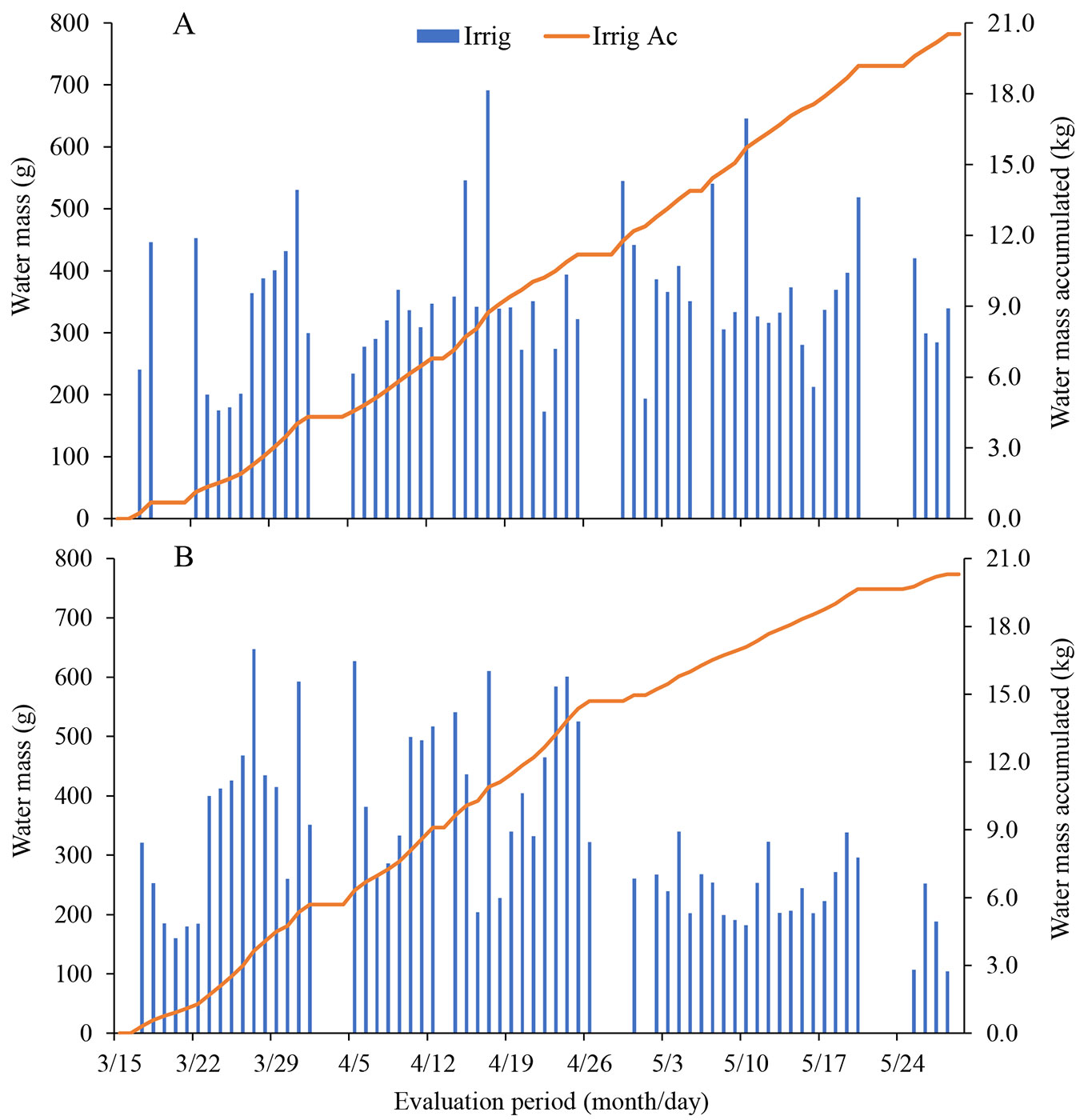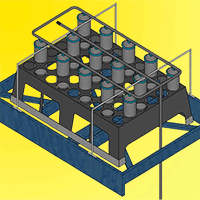
Automated irrigation management system for tree species seedlings using weighing mini-lysimeters
iForest - Biogeosciences and Forestry, Volume 17, Issue 4, Pages 222-228 (2024)
doi: https://doi.org/10.3832/ifor4409-017
Published: Aug 03, 2024 - Copyright © 2024 SISEF
Research Articles
Abstract
Due to the lack of irrigation management techniques, the application of water in forest nurseries is generally carried out without control, resulting in great waste. This study aimed to develop and evaluate weighing mini-lysimeters (ML) to automate the irrigation system and determine the water demand and evaluation of the initial tree species seedling growth. The structure was built out of wood to fit a tray of 54 tubes measuring 280 cm³. It was equipped with a load cell with a nominal capacity of 10 kg, located in the center of the structure. The mass variations of the set were recorded on a micro SD card using an Arduino Mega board, which allowed for the automated irrigation management system through an algorithm. Two MLs were built, determining the water demand of Dalbergia nigra (DN) and Enterolobium contortisiliquum (EC) seedlings in the initial growth phase. After calibration, the MLs presented an absolute error and mean squared error below 1% of the total mass, allowing effective irrigation control. During the evaluation period, 1.47 L seedling-1 of DN and 1.45 L seedling-1 of EC were applied, reaching 89 days after emergence, height and stem diameter of 39.2 cm and 3.4 mm, and 19.3 cm and 4.6 mm, respectively. The weighing mini-lysimeters developed demonstrated the ability to automate the irrigation of tree species seedlings, reducing the amount of water applied in forest nurseries.
Keywords
Evapotranspiration, Nursery, Mini-lysimeters, Dalbergia nigra, Brazilian rosewood, Enterolobium contortisiliquum, Pacara earpod tree
Introduction
Due to the large area devastated in many ecosystems and also to sustainable forest management programs, reforestation/restoration processes are needed, making it essential to produce high-quality and rustic seedlings, which are above all influenced by the availability of water, both in time and volume ([14]). Although forest nurseries focus on producing seedlings efficiently and economically, there is growing interest in reducing environmental impacts, especially those caused by excess water in irrigation ([28]).
Historically, water consumption in forest nurseries has always been high for different reasons, including the lack of knowledge regarding the water demand of species ([2]) and the influence of their architecture on water capture ([9]), the characteristics of production in tubes, such as the spacing of plants in the trays, in addition to the physical characteristics of the substrate and the irrigation system ([17]).
In tropical climates, the average water depth applied in forest nurseries is 14 mm day-1 ([29]), reaching 20 mm in nurseries with less irrigation control. This generates a large waste of water, which can reach 72% depending on the species ([10]). According to Carvalho et al. ([7]), traditionally, irrigation in forest nurseries is carried out without any type of management, which harms the efficiency of the system and the quality of the seedlings produced. As concerns about water use are growing around the world ([12]), it is essential to improve irrigation efficiency in nurseries to ensure economic and environmental sustainability ([13]).
Hydrological applications by irrigation systems should be developed based on crop evapotranspiration (ET), which is the amount of water transferred from the soil and plants to the atmosphere, in a given time step ([23]). ET is the most active variable in the hydrological cycle and the main component in the water balance in agricultural ecosystems ([6]), and can be estimated by mathematical models or measured directly by electronic instruments and sensors, and by weighing lysimeters ([15]). When designed on a small scale, they are called mini-lysimeters and are effective in monitoring ET and automatic irrigation scheduling ([18]).
Lysimetry has been used extensively to provide data for developing, calibrating and validating ET determination methods. However, the effectiveness of the method is related to the scale in which this equipment is used as the extrapolation of data obtained inside the lysimeter can lead to ET estimative errors ([1]). In weighing lysimetry, mass variations result in variations in the electrical signal of the load cell and are related to the ET process, providing information on water consumption by the crop ([18]). Lysimeters can also be connected to microcontrollers, enabling the collection and analysis of ET data and even the automatic activation of the irrigation system, applying water in adequate quantity and time, according to the crop water demand analysis in real time. Thus, water is replaced autonomously, maintaining the humidity of the soil/substrate in the lysimeter at adequate levels for crop development.
This study aimed to develop and evaluate an automated irrigation system for tree species seedlings using weighing mini-lysimeters, as well as determine the water demand and initial seedling growth in the Atlantic Forest biome.
Material and methods
Development and evaluation
The present study was carried out at the Hydraulics and Irrigation Laboratory at the Engineering Department of the Federal Rural University of Rio de Janeiro - UFRRJ, Brazil (22° 48″ 00″ S, 43° 41″ 00″ W; altitude: 30 m a.s.l.). The weighing mini-lysimeter (ML) was made out of wood and based on the model proposed by Carvalho et al. ([5]), being small in size and easy to install, and designed to assess the water requirement of seedlings of tree species in forest nurseries.
The structure, measuring 0.70 × 0.49 × 0.138 m, can fit a seedling tray of 54 tubes of 280 cm3 (Fig. 1A). It has articulated transverse bars to concentrate the bulk (tray + seedlings) in a load cell with a nominal capacity of 10 kg, located in the middle of the structure (Fig. 1B).
Fig. 1 - Wooden mini-lysimeter structure (A) and seedling tray with the position of 14 tubes and irrigation system (B).
A data collection system was developed to store information on a micro SD card using the Serial Peripheral Interface (SPI) module ([26]), generating an output report in text file format (txt) containing the following information every 10 min: date, day of the week, time, mass of the set, and mass of water applied to irrigation (if any). For data collection and storage, an Arduino Mega 2560 electronic prototyping board (Arduino, Somerville, MA, USA) was used, which operates with a nominal voltage of 5.0 or 3.3 V and has 54 digital input/output pins, 15 of which can be used as Pulse with Modulation (PWM) outputs and 16 analog inputs. The board’s microcontroller is based on the 8-bit ATmega2560 and the processor operates with a 16 MHz crystal oscillator, and SPI, Inter-Integrated Circuit (I2C) and Universal Synchronous Asynchronous Receiver Transmitter (UART) communication protocols.
The ML was calibrated according to the methodology presented by Carvalho et al. ([5]) and Vilela et al. ([33]). To do this, tubes with substrate were added and removed from the tray in 5 loading and unloading cycles. At each mass variation, the signal from the load cell was recorded and transformed into mass values for microcontroller readings.
The amplification of the electrical signal and the conversion to digital signal was performed by the HX711 module, allowing to relate the electrical signal of the load cell to mass values, after calibration. This module has two power supply pins (VCC and GND), two load cell power supply pins (E+ and E-) and 4 load cell signal reading pins (A+, A-, B+, B-). The DT and SCK pins are data and clock output pins, respectively.
Using the calibration data, the precision and accuracy of the ML were evaluated by correlation analysis and by calculating the standard deviation, coefficient of variation, besides the Mean Absolute Error (MAE), Root Mean Square Error (RMSE) and percentage bias (PBIAS - [21]).
Automated irrigation
Concerning automated irrigation, an algorithm was implemented in the microcontroller that (at 5:00 am) calculates the difference on a daily basis in mass relative to two consecutive readings on the LM (Fig. 2), serving as a reference for irrigation. This time was chosen due to the lower occurrence of environmental factors such as wind and high temperatures, which could cause deviations in the mass calculated by the load cell. Therefore, irrigation was programmed to trigger daily, in response to mass variation in the ML.
The irrigation system consisted of drippers (Netafim, PCJ-LCNL) with a nominal flow of 2.0 L h-1, with 1 emitter per seedling, totaling 14 emitters per lysimeter. The flow evaluation indicated the uniformity of emitters above 97%.
At the entrance to the irrigation system, a solenoid valve (Emicol/12V, class H) was installed, normally closed, activated by a relay module connected to a digital port of the microcontroller. When the calculated mass difference value is positive, the algorithm emits an electrical signal activating the relay. At this moment, the energization promotes the opening of the solenoid valve, allowing automatic irrigation of the seedlings.
The irrigation time (t) was calculated by the ratio between the daily mass variation (Δ) and the dripper flow rate (q). Before starting the ML monitoring, the tubes were soaked long enough to start draining. After percolation was completed, the tubes were distributed in the tray and the initial mass of the set was determined, serving as a reference for the first week of the experiment.
Water demand of tree species seedlings
The evaluation of the ML programming and functioning and, simultaneously, determining the water requirement of the seedlings in the initial growth phase were carried out for two tree species of the Atlantic Forest biome: Dalbergia nigra (Vell.) Allemão ex Benth (DN) and Enterolobium contortisiliquum (Vell.) Morong (EC), and for that, 2 ML were built.
The seedlings were sown in 280 cm3 tubes filled with pure biosolid, and irrigated by microsprinklers up to 14 days after emergence (DAE), when they were placed in the MLs measuring, on average, 6.36 and 7.55 cm in height and 1.12 mm and 1.28 mm in diameter, respectively, for DN and EC. These variables were monitored periodically. The tubes were spaced in the tray corresponding to a population density of 33 seedlings per square meter, so that there was no competition among the seedlings, and to guarantee enough physical space to grow better.
The initial masses registered in the ML were 6132.801 g for DN and 7660.228 g for EC. The MLs were assembled on a bench covered by commercial, black-colored polyolefin agricultural nets (Sombrite®), with nominal shading of 30%, and with plastic sheeting to prevent the seedlings from becoming wet due to rainwater.
Data collection was carried out over 55 days, from April 8th, 2022 to May 29th, 2022. The temperature and relative humidity were recorded inside the bench using a digital thermo-hygrometer (IMPAC/IP-747 RH). Depending on the seedling growth, the reference mass in each ML is changed, thus, the mass value of the set (tray + tubes) in the post-irrigation condition (field capacity) was updated weekly in the schedule.
Cost of automatic system components
Aiming to evaluate the viability of the developed automatic system for controlling irrigation in forest seedling nurseries, a survey of the market prices of the components used was carried out. It should be noted that this is only the cost of acquiring components, not considering costs related to the process of development and assembly of the system.
Results and discussion
Evaluation of the precision and accuracy of the mini-lysimeter
The results obtained in the ML calibration were satisfactory, indicating a high correlation between the values estimated by the HX711 and the actual mass of the tubes (Fig. 3). Therefore, the R2 value associated with the mean values of standard deviation (49.89 and 20.78 g), coefficient of variation (3.16% and 1.98%), MAE (0.060 and 0.090 g) and RMSE (27.24 and 19.01 g) corresponded to less than 1% of the total mass on the MLs, indicating good accuracy and precision of the model in determining the mass. According to Mccauely & Nackley ([18]), with this level of precision and accuracy, the ML can effectively control irrigation, with negligible errors. The PBIAS values found were expressively low (close to zero), indicating that there was no tendency to overestimation or underestimation of the data ([21]).
Fig. 3 - Calibration curve of mini-lysimeters used in the automation of irrigation of Dalbergia Nigra (A) and Enterolobium contortisiliquum (B) seedlings. (MAE): Mean Absolute Error; (RMSE): Root Mean Square Error; (PBIAS): percentage bias.
Water demand evaluation of seedlings
During the evaluation period, 57 irrigations were recorded for DN (Fig. 4A) and 55 irrigations for EC (Fig. 4B), which totaled 20.53 and 20.30 L of water per tray, respectively. On average, the total water demand was 1.47 L seedling-1 and 1.45 L seedling-1 in DN and EC, respectively. Using automatic irrigation management, Bueno et al. ([3]) evaluated the growth of DN seedlings and found a value of 3.1 L per seedling, with 37 and 58% shading. Despite evaluating the same species, the study developed by Bueno et al. ([3]) was carried out for 110 days, and the seedlings reached, on average, height and stem diameter greater than 45.0 cm and 4.0 mm, respectively. Furthermore, most of the experimental period occurred in the spring period, with reference evapotranspiration reaching 7.7 mm day-1.
Fig. 4 - Masses of water applied and accumulated in trays with 14 tubes of Dalbergia nigra (A) and Enterolobium contortisiliquum (B).
During part of the equipment evaluation period, temperature and relative humidity data were also collected (Fig. 5), which also influenced the water demand by species. The highest temperature was recorded on April 16th (48.1 °C) providing the highest irrigation depth in the DN seedlings.
Fig. 5 - Temperature (°C) and relative humidity (%) values in part of the growth period and evaluation of the seedlings.
The largest water volumes applied daily per tube in response to the evaporimetric demand were 691 mL (DN) on April 17th, and 647.7 mL (EC) on March 27th. On the following days, measurements were taken of the height and stem diameter in the seedlings, which presented mean values of 18.25 cm and 1.43 mm (DN) at 47 DAE and 10.40 cm and 1.79 mm (EC) at 27 DAE, respectively.
The difference between the water volumes used during the data collection period can be explained by climatic variations, the stage of development of the seedlings and the ecological characteristics of the species. According to Monteiro et al. ([20]), generally, the water demand for forest seedlings increases according to the solar radiation, but the water demand of the plant is also related to its development. Using a mini-lysimeter, Liyanage et al. ([16]) also observed variations between irrigation events and associated these differences with plant size, as the larger seedlings use substrate water more quickly than the smaller ones. Therefore, the species growth must be known to better understand these variations in consumption as observed in the present study.
The average water volumes applied were 16.9, 19.5 and 21.3 mL day-1 seedling-1 of DN, respectively, in March, April and May, corresponding to 19.6, 39.8 and 40.6% of the total volume applied. For EC, the volumes were 22.4, 22.9 and 13.7 mL day-1 seedling-1, in the respective months, corresponding to 26.3, 47.3 and 26.4% of the total volume applied. Therefore, there is a variation in the water consumption of seedlings in the different species.
Evaluation of seedling development
The evaluation of seedlings in height and stem diameter as a function of DAE (Fig. 6A, Fig. 6C) and water volume applied per tube (Fig. 6B, Fig. 6D) demonstrates different growth rates between species. DN seedlings showed increasing rates of development, reaching the dispatch standard at 83 DAE (Fig. 6A), measuring 36.0 cm in height and 3.0 mm in diameter ([8]). At 89 DAE, the seedlings were 39.2 cm and 3.4 mm, respectively. On the other hand, EC seedlings showed stable and, subsequently, decreasing rates of development, reaching 19.3 cm in height and 4.6 mm in diameter at the end of the same period (Fig. 6C). It is worth mentioning that the time for producing seedlings in the nursery varies, depending on the species and environmental conditions. Souza Junior & Brancalion ([30]) reported that EC seedlings acquire a commercial standard and are ready to be taken to the field when they reach heights of 30-60 cm and stem diameter of 2-3 mm.
Fig. 6 - Growth in height (cm) and diameter (mm) of the sample as a function of days after emergence and water volume applied per tube of D. nigra (A, B) and E. contortisiliquum (C, D).
Fig. 6B and Fig. 6D confirm the difference in the water demand of the species (Fig. 4) as a function of growth in height and diameter, with positive (DN) and negative (EC) parameters for the quadratic term of the models. At 55 DAE, DN seedlings reached 54.3% of their growth in height (21.34 cm) and diameter (1.84 mm), while EC seedlings reached 84.5% of their height (16.32 cm) and 79.6% of the diameter (3.65 mm) in the same period. EC seedlings were collected when the mean diameter was greater than 4.5 mm, while the mean height was lower than that of DN seedlings.
The differences observed in Fig. 6are associated with the species growth habits evaluated in this study. The classification of Enterolobium contortisiliquum in ecological groups is discussed by several authors, being classified from pioneer to initial secondary with a tendency to climax, with great ecological plasticity, being found in several phytoecological regions ([4]). Its growth characters show substantial variation between progenies ([25]) which may have contributed to the species presenting a slow growth in height in the month of May. Thus, the greatest growth in diameter (Fig. 6C and Fig. 6D) can be a strategy for resistance to environmental factors, both in the field ([24]) and in the nursery phase ([32], [34]).
Dalbergia nigra is a semi-heliophilous species, which tolerates light shading, and is classified as secondary succession, producing better quality seedlings when subjected to shading ([3]). Its growth ranges from moderate to rapid, and the greatest increase in height occurs in production environments with shading of up to 30%.
The demand for light in forest species and the variety of growth habits result in developing stratified communities, in which one species presents greater development of the aerial part (DN) when compared to those cultivated in full sun (EC). Fast growth in moderately shaded environments is an adaptive characteristic of secondary growth species, which reflects on their photosynthetic capacity in environments of low light intensity ([22], [31]).
Cost analysis for developing the mini-lysimeter
The cost analysis of the materials used for the developed mini-lysimeter is presented in Tab. 1. The cost to make the ML was US$ 81.82, which is considered low when compared to the water and energy savings that are spent on seedling production nurseries in general, mainly forest species. Other systems were evaluated in forest nurseries, but without mentioning the installation/operation cost. Bueno et al. ([2], [3]) and Silva et al. ([27]) used an automatic irrigation trigger to produce seedlings of different tree species from the Atlantic forest. The device was proposed by Medici et al. ([19]) and operates in response to substrate water tension and is regulated by the level difference between a ceramic micro-cup (sensor) and a pressure switch. Dumroese et al. ([11]) presented a methodology based on the periodic weighing of containers of seedlings, which despite using the same principle used in this study, requires great availability of labor.
Tab. 1 - Prices of components used to develop the automated irrigation system. Quotation of June 26th, 2023.
| Material | Unit value (US$) |
Quantity used |
Value per mini-lysimeter (US$) |
|---|---|---|---|
| Solenoide | 4.37 | 1 | 4.37 |
| Load cell | 11.09 | 1 | 11.09 |
| Relay Module | 2.57 | 2 | 5.14 |
| Arduino Mega | 54.17 | 1 | 54.17 |
| HX711 Module | 2.57 | 2 | 5.14 |
| Drippers | 0.14 | 14 | 1.91 |
| Total | - | - | 81.82 |
Conclusions
The lack of irrigation management in forest nurseries implies a waste of water in seedling production systems, which may affect their quality. The amount of water applied by irrigation depends on the crop evapotranspiration and can be measured using lysimetry of weights. Here, we developed and evaluated an automated irrigation system for tree species seedlings using weighing mini-lysimeters, and determined the water demand and initial seedling growth of DN and EC. The proposed mini-lysimeters showed adequate sensitivity, indicating a high correlation between the values estimated by the HX711 module and the actual mass of the tubes. The mean absolute error and mean square error were less than 1% of the total mass on the MLs, and were indicated for the evapotranspiration determination of tree species seedlings. The mini-lysimeters developed led to automated irrigation management and the water demand evaluation of DN and EC seedlings in the initial growth phase, reducing the amount of water applied in forest nurseries. Although the volume of water applied was similar, around 1.45 L per seedling after 89 days of monitoring, the seedlings presented a development compatible with the characteristics of the species.
List of abbreviations
ML: mini-lisimeter; DN: Dalbergia nigra; EC: Enterolobium contortisiliquum; ET: crop evapotranspiration; SPI: Serial Peripheral Interface; PWM: Pulse with Modulation; UART: Universal Synchronous Asynchronous Receiver Transmitter; MAE: Mean Absolute Error; RMSE: Root Mean Square Error; PBIAS: percentage bias; DAE: days after emergence.
Acknowledgments
We acknowledge the Carlos Chagas Filho Foundation for the Research Support in the State of Rio de Janeiro (FAPERJ) for the financial support (E-26/202.909/2018), the National Council for Scientific and Technological Development (CNPq) for the scholarship granted (Process 133663/2020-5) and financial support (Process 310604/ 2018-4). This study was also financed in part by the Coordination of Superior Level Staff Improvement (CAPES) - Finance Code 001. We would like to thank the Federal Rural University of Rio de Janeiro, specifically the Postgraduate Program in Agronomy - Soil Science (PPGA-CS) and Water and Soil in Agriculture Systems Research Group (GPASSA).
References
Gscholar
Gscholar
CrossRef | Gscholar
Gscholar
Authors’ Info
Authors’ Affiliation
Marinaldo Ferreira Pinto 0000-0002-9368-6122
Engineering Department, Technology Institute, Federal Rural University of Rio de Janeiro (UFRRJ). BR-465 Highway, km 7, 23890-000 (Brazil)
Graduate Program in Agronomy - Soil Science. Agronomy Institute, Federal Rural University of Rio de Janeiro (UFRRJ). BR-465 Highway, km 7, Seropédica - RJ, 23897000 (Brazil)
UFRRJ, BR-465 Highway, km 7, Seropédica - RJ, 23897000 (Brazil)
Faculty of Agricultural Sciences. São Paulo State University - UNESP, Rua José Barbosa de Barros, 1780, Jardim Primavera, Botucatu - SP, 18610307 (Brazil)
Corresponding author
Paper Info
Citation
Fonseca de Carvalho D, Rodrigues da Costa G, Faria Conforto BAA, Ferreira Pinto M, Ribeiro da Silva M (2024). Automated irrigation management system for tree species seedlings using weighing mini-lysimeters. iForest 17: 222-228. - doi: 10.3832/ifor4409-017
Academic Editor
Pierluigi Paris
Paper history
Received: Jun 26, 2023
Accepted: Mar 14, 2024
First online: Aug 03, 2024
Publication Date: Aug 31, 2024
Publication Time: 4.73 months
Copyright Information
© SISEF - The Italian Society of Silviculture and Forest Ecology 2024
Open Access
This article is distributed under the terms of the Creative Commons Attribution-Non Commercial 4.0 International (https://creativecommons.org/licenses/by-nc/4.0/), which permits unrestricted use, distribution, and reproduction in any medium, provided you give appropriate credit to the original author(s) and the source, provide a link to the Creative Commons license, and indicate if changes were made.
Web Metrics
Breakdown by View Type
Article Usage
Total Article Views: 9186
(from publication date up to now)
Breakdown by View Type
HTML Page Views: 5978
Abstract Page Views: 1522
PDF Downloads: 1441
Citation/Reference Downloads: 0
XML Downloads: 245
Web Metrics
Days since publication: 501
Overall contacts: 9186
Avg. contacts per week: 128.35
Article Citations
Article citations are based on data periodically collected from the Clarivate Web of Science web site
(last update: Mar 2025)
(No citations were found up to date. Please come back later)
Publication Metrics
by Dimensions ©
Articles citing this article
List of the papers citing this article based on CrossRef Cited-by.
Related Contents
iForest Similar Articles
Research Articles
Mini-tunnel and season influence in clonal garden on the production of clonal seedlings for two subtropical clones: Eucalyptus saligna and Corymbia torelliana × Corymbia citriodora
vol. 18, pp. 154-162 (online: 09 June 2025)
Technical Reports
De novo adventitious root formations in mini-cuttings of Azadirachta indica in response to different rooting media and auxin treatments
vol. 8, pp. 558-564 (online: 09 December 2014)
Research Articles
Allometric relationships for predicting the stem volume in a Dalbergia sissoo Roxb. plantation in Bangladesh
vol. 3, pp. 153-158 (online: 15 November 2010)
Research Articles
Evaluation of fast growing tree water use under different soil moisture regimes using wick lysimeters
vol. 6, pp. 190-200 (online: 08 May 2013)
Research Articles
Verification of new Populus nigra L. clone improvement based on their performance over three rotations
vol. 13, pp. 185-193 (online: 12 May 2020)
Research Articles
Nursery screening of poplar and willow clones for biofuel application in Ukraine
vol. 15, pp. 401-410 (online: 06 October 2022)
Research Articles
Nursery fertilization affected field performance and nutrient resorption of Populus tomentosa Carr. ploidy levels
vol. 15, pp. 16-23 (online: 24 January 2022)
Research Articles
Use of brassinosteroids to overcome unfavourable climatic effects on seed germination in Pinus nigra J. F. Arnold
vol. 17, pp. 1-9 (online: 02 February 2024)
Research Articles
Variation of wood and bark density and production in coppiced Eucalyptus globulus trees in a second rotation
vol. 9, pp. 270-275 (online: 08 September 2015)
Research Articles
Thermo-modified native black poplar (Populus nigra L.) wood as an insulation material
vol. 14, pp. 268-273 (online: 29 May 2021)
iForest Database Search
Google Scholar Search
Citing Articles
Search By Author
Search By Keywords

